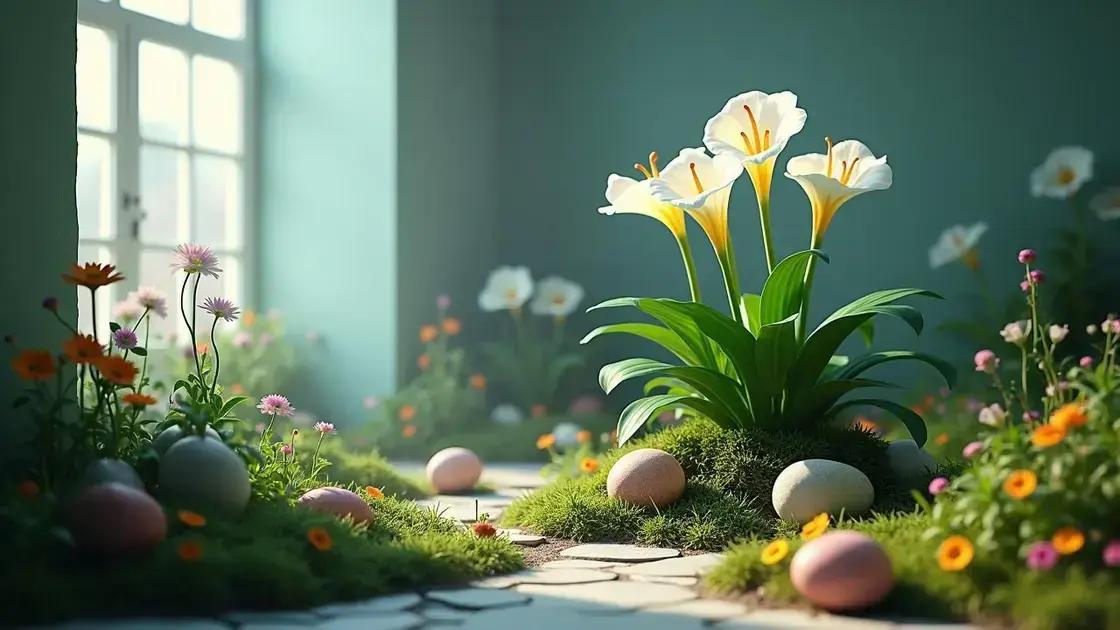How to Take Care of Easter Lily Plant Indoor: 5 Essential Tips
How to take care of easter lily plant indoor can seem daunting, but with the right knowledge, anyone can cultivate these stunning flowers. The secret is to provide the appropriate care that meets their unique needs. Curious about how to foster a vibrant, healthy indoor oasis? Discover essential tips to ensure your easter lilies thrive in your space!
Table of Contents
ToggleUnderstanding the easter lily watering needs
Understanding the easter lily watering needs is vital for maintaining a healthy indoor plant. Easter lilies require consistent moisture but dislike waterlogged soil. Finding the right balance can help your lilies flourish.
Identifying Your Watering Schedule
To ensure proper growth, follow these tips for a successful watering routine:
- Water the plant thoroughly, allowing excess water to drain.
- Check the soil moisture level before watering. If the top inch of soil feels dry, it’s time to water.
- Adjust your watering frequency based on the season; often, indoor environments may require more frequent watering in warmer months.
Signs of Overwatering and Underwatering
Recognizing the signs of improper watering can help you adjust your care:
- Overwatering: Yellowing leaves, wilting, or root rot.
- Underwatering: Dry, brown leaf tips, wilting, or slow growth.
Optimal Watering Techniques
Implement these techniques to promote healthy watering habits:
- Use room temperature water to avoid shocking the plant.
- Water early in the day to allow excess moisture to evaporate.
- Avoid letting the pot sit in standing water for extended periods.
Additional Tips for Successful Indoor Easter Lily Care
For a thriving easter lily, remember:
- Enhance soil drainage with perlite or sand to prevent water retention.
- Consider the impact of humidity; the ideal indoor humidity level should be between 40% and 60%.
- Utilize self-watering pots if you travel frequently or have a busy schedule.
For further insights, feel free to explore indoor gardening techniques, where you can find more valuable tips for maintaining your indoor plants.
Optimal light requirements for your indoor easter lilies

Optimal light requirements for your indoor easter lilies are essential for promoting healthy growth and vibrant blooms. These beautiful flowers thrive under specific lighting conditions that mimic their natural habitat.
The importance of light for easter lilies
Understanding the role of light in plant health is crucial:
- Light fuels photosynthesis, which is vital for growth.
- Proper light exposure enhances blooming and overall vitality.
- Insufficient light can lead to leggy plants with fewer flowers.
Ideal lighting conditions
Here are the optimal lighting conditions to consider for your easter lily:
- Bright indirect light: Position your lilies near a window that offers bright, filtered sunlight.
- Avoid direct sunlight: Direct sunlight can scorch the leaves and damage the flowers.
- Rotate the plant: Turn your easter lilies occasionally to ensure even light exposure on all sides.
Signs of inadequate light
Be on the lookout for signs that your easter lilies may not be receiving enough light:
- Leggy growth with long stems and sparse leaves.
- Pale or yellowing leaves.
- Delayed flowering or reduced bloom count.
Supplementing with artificial light
If natural light is insufficient, consider these options to supplement light:
- Use full-spectrum grow lights for consistent lighting.
- Position lights about 12-18 inches above the plants.
- Provide 12-14 hours of light for optimal growth.
For more insights, you might find useful information by exploring indoor gardening techniques. This can greatly benefit your indoor gardening journeys and your easter lilies.
Effective pest control strategies for indoor lilies
Effective pest control strategies for indoor lilies are essential to maintain the health and beauty of your plants. Recognizing and managing pests early can prevent damage and ensure vibrant blooms.
Common pests affecting indoor easter lilies
Understanding which pests may invade your lilies can help you take proactive measures:
- Silvery whitefly: Small insects that suck sap, leading to leaf yellowing.
- Aphids: These tiny pests can cluster on new growth, causing distortion.
- Spider mites: Microscopic pests that cause stippling on leaves and can lead to webbing.
- Fungus gnats: Small flies that thrive in moist soil, indicating overwatering.
Preventative measures and cultural controls
Apply these strategies to minimize the risk of infestations:
- Inspect new plants before introducing them to your indoor garden.
- Maintain proper watering practices to avoid overly moist soil.
- Provide adequate airflow around plants to reduce humidity levels.
- Regularly clean leaves with a damp cloth to remove dust and potential eggs.
Effective treatments for pest infestations
If your indoor easter lilies do become infested, consider these treatment options:
- Neem oil: A natural pesticide that disrupts pest life cycles.
- Insecticidal soap: Effective against soft-bodied pests like aphids and mites.
- Sticky traps: Help catch flying adults like whiteflies and fungus gnats.
- Beneficial insects: Introducing predatory insects such as ladybugs can help control pest populations.
Monitoring and ongoing care
Regular monitoring is key to effective pest control:
- Inspect plants weekly for signs of pests or damage.
- Keep a journal of pest activity to identify patterns and make adjustments accordingly.
- Stay informed by exploring indoor gardening techniques to discover new methods and tips for healthy plants.
In conclusion
Taking care of easter lilies indoors can be a rewarding experience with the right knowledge and practices. By understanding their watering needs, providing optimal light conditions, and implementing effective pest control strategies, you can enjoy vibrant blooms in your home. Consistently monitor your plants and adjust your care as necessary to foster healthy growth. For additional advice and resources, check out tips on enhancing your indoor garden.

